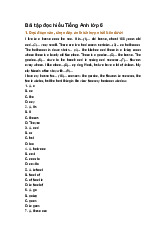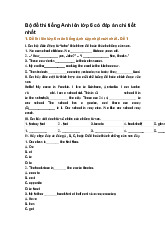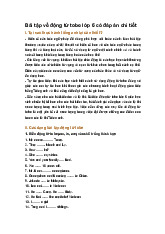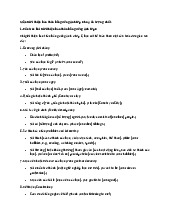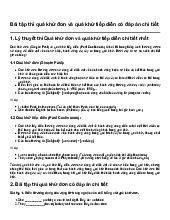Preview text:
TIENG ANH 6 I-LEARN SMART WORLD
REVISION FOR THE FINAL TEST SEMESTER 1
VOCABULARY & GRAMMAR UNIT 1: HOME A. Vocabulary 1. House Từ Từ loại Phát âm Nghĩa pool (n) /puːl/ Bể bơi balcony (n) /ˈbælkəni/ Ban công garage (n) /ɡəˈrɑːʒ/ Nhà để xe, ga-ra yard (n) /jɑːrd/ Cái sân gym (n) /dʒɪm/ Phòng tập thể dục apartment (n) /əˈpɑːrt mənt/ Chung cư 2. Housework Từ Từ loại Phát âm Nghĩa do the laundry (v.phrase) /duː ðə ˈlɔːndri/ Giặt quần áo
clean the kitchen (v.phrase) /kliːn ðə ˈkɪtʃən/ Lau dọn nhà bếp make dinner (v.phrase) /meɪk ˈdɪnər/ Nấu bữa tối make the bed (v.phrase) /meɪk ðə bed/ Dọn giường do the dishes (v.phrase) /duː ðə dɪʃɪz/ Rửa bát
do the shopping (v.phrase) /duː ðə ˈʃɒpɪŋ/ Đi mua sắm 3. Hometown Từ Từ loại Phát âm Nghĩa south (n) /saʊθ/ Phía nam west (n) /west/ Phía tây north (n) /nɔːrθ/ Phía bắc east (n) /iːst/ Phía đông center (n) /ˈsentər/ Trung tâm city (v) /ˈsɪti/ Thành phố village (n) /ˈvɪlɪdʒ/ Ngôi làng 1 town (n) / taʊn/ Thị trấn, thị xã B. Grammar
1. Present Simple (Thì Hiện tại đơn) a. Công thức Động từ thường Động từ To be ● I + am + N/ Adj.
● I/ You/ We/ They/ DT số nhiều + V- ● inf.
You/ We/ They/ DT số nhiều + are + (+) N/ Adj.
● He/ She/ It/ DT số ít/ DT không đếm được + V(s/es). ●
He/ She/ It/ DT số ít/ DT không đếm
được + is + N/ Adj. ● I am not + N/ Adj.
● I/ You/ We/ They/ DT số nhiều + don’t ● + V-inf.
You/ We/ They/ DT số nhiều + aren’t (-) + N/ Adj.
● He/ She/ It/ DT số ít/ DT không đếm được + doesn’t ● + V-inf.
He/ She/ It/ DT số ít/ DT không đếm
được + isn’t + N/ Adj. Do / Does + S + V-inf?
Am / Are / Is (not) + S + N/ Adj? ● Yes, S + do / does. ● Yes, S + am / are / is. (?)
● No, S + don’t / doesn’t.
● No, S + am not / aren’t / isn’t.
Wh- + do/ does (not) + S + V-inf?
Wh- + am/ are/ is (not) + S + N/ Adj)? b. Cách dùng
❖ Diễn tả một thói quen hoặc một hành động có tính lặp đi lặp lại ở hiện tại.
❖ Diễn tả một chân lý hoặc một sự thật hiển nhiên.
❖ Diễn tả một sự việc sẽ xảy ra trong tương lai theo thời gian biểu hoặc lịch trình.
c. Dấu hiệu nhận biết
❖ Cụm từ với “every”: every day, every year, every month, every afternoon, every morning, every evening, etc.
❖ Cụm từ chỉ tần suất: once a week, twice a week, three times a week, four times a week, five times
a week, once a month, once a year, etc.
❖ Trạng từ chỉ tần suất: always, usually, often, sometimes, never, rarely... 2
d. Thêm “s/es” vào động từ
❖ Thông thường: thêm “-s” vào sau các động từ.
❖ Những động từ tận cùng bằng -s; -sh; -ch; -z; -x; -o 🡪 thêm “-es”. (miss, watch, mix, wash, go)
❖ Những động từ tận cùng là “y”:
+ Nếu trước “y” là một nguyên âm (a, e, i, o, u) 🡪 giữ nguyên “y” + “-s”. (play, buy, pay)
+ Nếu trước “y” là một phụ âm 🡪 đổi “y” thành “i” + “-es”. (fly, cry, fry)
2. Possessive: ’s (Sở hữu cách)
Sở hữu cách được dùng để chỉ sự sở hữu hay một mối liên hệ giữa 2 hay nhiều đối tượng, từ đó
làm rõ thêm cho đối tượng đang được nhắc đến.
❖ B thuộc sở hữu của A, B thuộc về A. (B thường là chỉ vật.)
❖ B có mối quan hệ nào đó với A. (B thường là người.)
* Cách viết ký hiệu sở hữu cách:
❖ Thêm dấu lược và chữ cái “s” vào sau danh từ số ít.
❖ Thêm dấu lược vào sau danh từ số nhiều có tận cùng là “s”.
❖ Thêm dấu lược và chữ cái “s” vào sau danh từ số nhiều không có tận cùng là “s”. UNIT 2: SCHOOL A. Vocabulary 1. School subjects Từ Từ loại Phát âm Nghĩa history (n) /ˈhɪstri/ Môn Lịch sử P.E
/piː iː/ (n) Môn Thể dục (physical education)
(/ˌfɪz.ɪ.kəl ed.jʊˈkeɪ.ʃən/) I.T /aɪ ’ti:/ (n) Môn Tin học
(information technology)
(/ɪnfəˌmeɪʃən tekˈnɒlədʒi/) music (n) /ˈmjuː.zɪk/ Môn Âm nhạc geography (n) /dʒiˈɒɡrəfi/ Môn Địa lý literature (n) /ˈlɪt.rə.tʃər/ Môn Văn học physics (n) /ˈfɪzɪks/ Môn Vật lý biology (n) /baɪˈɒlədʒi/ Môn Sinh học 3 2. School activities Từ Từ loại Phát âm Nghĩa indoor activity (n.phrase)
/ˌɪnˈdɔːr ækˈtɪvəti/ Hoạt động trong nhà act (v) /ækt/ Diễn xuất drama club (n) /ˈdrɑː.mə klʌb/ Câu lạc bộ kịch sign up (v) /saɪn ʌp/ Đăng ký outdoor activity
(n.phrase) /ˈaʊtˌdɔːr ækˈtɪvəti/ Hoạt động ngoài trời arts and crafts (n)
/ˌɑːts ən ˈkrɑːfts/ Thủ công mỹ nghệ 3. Books Từ Từ loại Phát âm Nghĩa fantasy (n) /ˈfæntəsi/ Kỳ ảo author (n) /ˈɔːθər/ Tác giả novel (n) /ˈnɒvəl/ Tiểu thuyết mystery (n) /ˈmɪstəri/ Bí ẩn adventure (n) /ədˈventʃər/ Cuộc phiêu lưu B. Grammar
1. Using “and” / “or” for listing
- Sử dụng “and” để nối hai hoặc nhiều danh từ trong câu khẳng định.
- Sử dụng “or” để nối hai hoặc nhiều danh từ trong câu phủ định.
2. Possessive pronouns: “mine” and “yours”
a. Tính từ sở hữu (Possessive adjectives)
Tính từ sở hữu thể hiện tính chất sở hữu của người hoặc vật với danh từ đi sau nó. Các tính từ sở
hữu luôn đi trước danh từ mà nó sở hữu và các danh từ này không có mạo từ đi theo.
Đại từ nhân xưng Tính từ sở hữu I My You Your He His She Her It Its We Our They Their 4
b. Đại từ sở hữu (Possessive pronouns)
Đại từ sở hữu là từ chỉ sự sở hữu của người hoặc vật với người hoặc một sự vật khác. Đại từ sở
hữu được sử dụng để thay thế cho tính từ sở hữu theo sau để tránh lặp lại. (Đại từ sở hữu = Tính từ sở hữu + Danh từ).
Đại từ nhân xưng chủ ngữ Tính từ sở hữu Đại từ sở hữu Nghĩa I my mine của tôi you your yours của bạn/các bạn we our ours của chúng tôi they their theirs của họ he his his của anh ấy she her hers của cô ấy it its its của nó 3. Like + V-ing
- Động từ sau “like” luôn sử dụng ở dạng đuôi “-ing” để nói về các hoạt động tại trường học.
- Chúng ta sử dụng động từ dạng V-ing đằng sau những động từ chỉ sự thích/ ghét sau: Thích Ghét like hate love dislike enjoy UNIT 3: FRIENDS A. Vocabulary 1. Personal appearance Từ Từ loại Phát âm Nghĩa blond (adj) /blɒnd/ (Tóc) vàng blue (adj) /bluː/ Màu xanh dương 5 brown (adj) /braʊn/ Màu nâu glasses (adj) /ɡlæsiz/ Mắt kính long (n) /lɔŋ/ Dài red (adj) /red/ Màu đỏ short (adj) /ʃɔːrt/ Ngắn, thấp slim (adj) /slɪm/ Thon thả, gầy tall (adj) /tɔːl/ Cao 2. Activities Từ Từ loại Phát âm Nghĩa badminton (n) /ˈbædmɪntən/ Cầu lông barbecue (n) /ˈbaːrbikjuː/ Tiệc nướng ngoài trời beach (n) /biːtʃ/ Bãi biển cake (n) /keik/ Bánh ngọt mall (n) /mɔ:l/ Trung tâm thương mại movie (n) /ˈmuːvi/ Phim điện ảnh party (n) /ˈpɑːrti/ Bữa tiệc pizza (n) /ˈpiːtsə/ Bánh pi-za swimming (n) /ˈswɪmɪŋ/ Việc bơi lội TV (n) /ˌtiː ˈviː/ Ti vi video game (n) /ˈvɪdiəʊ ɡeɪm/ Trò chơi điện tử 3. Characteristics Từ Từ loại Phát âm Nghĩa helpful (adj) /ˈhelpfl/ Có ích selfish (adj) /ˈselfɪʃ/ Ích kỷ kind (adj) /kaɪnd/ Tử tế funny (adj) /ˈfʌni/ Buồn cười, vui nhộn friendly (adj) /ˈfrendli/ Thân thiện lazy (adj) /ˈleɪzi/ Lười biếng B. Grammar
1. Present continuous (Thì Hiện tại Tiếp diễn) a. Công thức 6 I + am + V-ing. (+)
You/ We/ They/ Danh từ số nhiều + are + V-ing.
He/ She/ It/ Danh từ số ít/ Danh từ không đếm được + is + V-ing. I + am not + V-ing. (-)
You/ We/ They/ Danh từ số nhiều + aren’t + V-ing.
He/ She/ It/ Danh từ số ít/ Danh từ không đếm được + isn’t + V-ing. Am/ Is/ Are + S + V-ing? ● Yes, S + am/ is/ are. (?)
● No, S + am not/ isn’t/ aren’t.
Wh + am/ is/ are (not) + S + V-ing? b. Cách sử dụng
❖ Diễn tả một hành động đang diễn ra tại thời điểm nói.
❖ Diễn tả một hành động hoặc sự việc đang diễn ra xung quanh thời điểm nói.
❖ Diễn tả một hành động sắp xảy ra trong tương lai gần (điều này đã được lên kế hoạch). Thường
sử dụng các cụm từ chỉ thời gian trong tương lai như this weekend, on Saturday, tomorrow, tonight, etc.
c. Dấu hiệu nhận biết
❖ Các trạng từ hay gặp: now, at the present, at the moment, at this time
❖ Các động từ: Look!, Listen, Be careful!, Hurry up!, Watch out! = Look out!
d. Thêm “-ing” vào động từ
❖ Thông thường nhất, ta thêm đuôi “-ing” vào sau các động từ.
❖ Khi động từ kết thúc bằng “e” 🡪 bỏ “e” trước khi thêm “-ing”. (have, make)
❖ Khi động từ kết thúc bằng “ee” 🡪 thêm “-ing” mà không bỏ “-e”. (see, agree)
❖ Khi động từ kết thúc bằng “ie” 🡪 đổi “ie” thành “y” rồi thêm “-ing”. (lie, die)
❖ Khi động từ có 1 âm tiết kết thúc bằng 1 phụ âm (trừ h, w, x, y) đi trước là 1 nguyên âm 🡪 gấp đôi
phụ âm cuối rồi thêm “-ing”. (run, stop, swim)
❖ Khi động từ có 2 âm tiết trở lên, nếu trọng âm nhấn vào âm cuối thì gấp đôi phụ âm, nếu trọng âm
không nhấn vào âm cuối thì không gấp đôi phụ âm. (permit, enter)
2. Một số động từ không chia ở thì hiện tại tiếp diễn 1. want 7. contain 13. depend 19. hate 2. like 8. taste 14. seem 20. wish 3. love 9. suppose 15. know 21. mean 7 4. prefer 10. remember 16. belong 22. lack 5. need 11. realize 17. hope 23. appear 6. believe 12. understand 18. forget 24. sound
UNIT 4: FESTIVALS AND FREE TIME A. Vocabulary
1. Adverbs of frequency Từ Từ loại Phát âm Nghĩa often (adv) /ˈɔːfn/ Thường never (adv) /ˈnevər/ Không bao giờ sometimes (adv) /ˈsʌmtaɪmz/ Thỉnh thoảng always (adv) /ˈɔːlweɪz/ Luôn luôn rarely (adv) /ˈrerli/ Hiếm khi usually (adv) /ˈjuːʒuəli/ Thường xuyên 2. Events Từ Từ loại Phát âm Nghĩa (music) /ˈmjuːzɪk (n.phrase)
Buổi trình diễn âm nhạc performance pərˈfɔːrməns/ (food) stand (n.phrase) /fuːd stænd/ Quầy bán hàng đồ ăn fashion show (n.phrase) /ˈfæʃn ʃəʊ/
Buổi trình diễn thời trang puppet show (n.phrase) /ˈpʌpɪt ʃəʊ/
Buổi trình diễn múa rối tug of war (n) /ˌtʌɡ əv ˈwɔːr/ Kéo co talent show (n.phrase) /ˈtælənt ʃəʊ/
Buổi trình diễn tài năng
3. A Vietnamese festival Từ Từ loại Phát âm Nghĩa fireworks (n) /ˈfaɪərwɜːrk/ Pháo hoa decorate (v) /ˈdekəreɪt/ Trang trí flower (n) /ˈflaʊər/ Hoa fruit (n) /fruːt/ Hoa quả gift (n) /ɡɪft/ Quà tặng 8 lucky money (n) /ˈlʌki ˈmʌni/ Tiền lì xì parade (n) /pəˈreɪd/ Buổi diễu hành traditional (adj) /trəˈdɪʃənl/ Truyền thống B. Grammar
1. Adverbs of frequency (Trạng từ chỉ tần suất) a. Định nghĩa
- Trạng từ chỉ tần suất là trạng từ dùng để biểu đạt hay mô tả về mức độ thường xuyên xảy ra của một
sự kiện, hiện tượng nào đó.
- Trạng từ chỉ tần suất dùng để trả lời câu hỏi “How often…?”
* Các trạng từ chỉ tần suất thường sử dụng: % Adverbs of frequency 100%
always (luôn luôn) 90%
usually (thường xuyên) 70%
often (thường thường) 50%
sometimes (thỉnh thoảng) 5% rarely (hiếm khi) 0%
never (không bao giờ)
Only approximate numbers
b. Vị trí của trạng từ chỉ tần suất trong câu
❖ Đứng sau động từ “to be”
❖ Đứng trước động từ chính và đứng sau chủ ngữ.
❖ Đứng giữa trợ động từ và động từ chính trong câu.
❖ Đôi khi đứng ở đầu câu hoặc cuối câu (trừ hardly ever, never)
2. Present Simple for future use
Thì Hiện tại đơn diễn tả công việc cụ thể (có kế hoạch xác định) trong tương lai như là thời khóa biểu
hay chương trình, lịch trình cụ thể.
- The meeting starts at 8.00 tomorrow.
- The train leaves at 5.00.
- The shops open at 7.00 tomorrow. UNIT 5: AROUND TOWN 9 A. Vocabulary 1. In a clothing store Từ Từ loại Phát âm Nghĩa large (n) /lɑːrdʒ/ Lớn, rộng extra large (n) /ˈekstrə lɑːrdʒ/ Rất lớn jeans (n) /dʒiːnz/ Quần bò changing room (n) /ˈtʃeɪndʒɪŋ ruːm/ Phòng thay đồ medium (n) /ˈmiːdiəm/ Cỡ trung bình sweater (n) /ˈswetər/ Áo len dài tay customer (n) /ˈkʌstəmər/ Khách hàng sales assistant (n) /ˈseɪlz əˈsɪstənt/ Nhân viên bán hàng 2. In a restaurant Từ Từ loại Phát âm Nghĩa order (v) /ˈɔːrdər/ Gọi món dessert (n) /dɪˈzɜːrt/ Món tráng miệng tip (n) /tɪp/ Tiền boa check (n) /tʃek/ Hóa đơn change (n) /tʃeɪndʒ/ Tiền thừa menu (n) /ˈmenjuː/ Thực đơn
3. Food around the world Từ Từ loại Phát âm Nghĩa fish sauce (n) /fɪʃ sɔːs/ Nước mắm fry (v) /fraɪ/ Rán, chiên noodles (n) /ˈnuːdl/ Mì grill (v) /ɡrɪl/ Nướng beef (n) /biːf/ Thịt bò seafood (n) /ˈsiːfuːd/ Hải sản lamb (n) /læm/ Thịt cừu herb (n) /hɜːrb/ Thảo mộc/ rau thơm pork (n) /pɔːrk/ Thịt lợn (heo) B. Grammar 10
1. Demonstratives (Đại từ chỉ định): This/ That/ These / Those a. Định nghĩa
Đại từ chỉ định (Demonstrative Pronouns) là những từ sử dụng để chỉ người hoặc vật, dựa vào
khoảng giữa người nói đến đối tượng họ đang muốn nhắc đến.
b. Vị trí của đại từ chỉ định trong câu
❖ Đại từ chỉ định làm chủ ngữ.
❖ Đại từ chỉ định làm tân ngữ.
❖ Đại từ chỉ định đứng sau giới từ (trong cụm giới từ).
c. Cách dùng đại từ chỉ định
Đi với danh từ số ít
Đi với danh từ số nhiều Khoảng cách This (này) These (những cái này) Gần That (kia, đó) Those (những cái kia) Xa
2. Object pronouns: “it” / “them”
Đại từ nhân xưng gồm Đại từ chủ ngữ (Subject pronouns) và Đại từ tân ngữ (Object pronoun).
❖ Đại từ nhân xưng được dùng để thay thế cho danh từ khi không cần thiết sử dụng hoặc lặp lại
chính xác danh từ hoặc cụm danh từ đó.
❖ Đại từ nhân xưng me, him, her, us, them có thể là tân ngữ trực tiếp của động từ.
❖ Đại từ nhân xưng có thể là tân ngữ gián tiếp của động từ.
❖ Đại từ nhân xưng có thể là tân ngữ của giới từ.
Đại từ nhân xưng Đại từ nhân xưng (Làm chủ ngữ) Tính từ sở hữu Đại từ sở hữu (Làm tân ngữ) I me MY MINE you you YOUR YOURS he him HIS HIS she her HER HER IT IT ITS ITS we us OUR OURS you you YOUR YOURS THEY THEM THEIR THEIRS
3. Countable & uncountable nouns (Danh từ số ít, số nhiều, đếm được và không đếm được)
a. Danh từ đếm được & Danh từ không đếm được 11
- Danh từ không đếm được: tea, water, sugar, ...
- Danh từ đếm được: danh từ đếm được gồm cả danh từ số ít và danh từ số nhiều:
❖ Danh từ số ít chỉ một người hay một vật
❖ Danh từ số nhiều chỉ hai người hoặc hai vật trở lên.
- Cách thành lập số nhiều cho danh từ đếm được:
❖ Thông thường: bỏ “a” thêm “-s” vào sau danh từ.
❖ Riêng các danh từ tận cùng là –s, -sh, -ch, -x: thêm “-es”. (buses, brushes)
❖ Những danh từ tận cùng là y và trước y là một phụ âm: đổi “y” thành “i” rồi thêm “-es”. (flies, lorries)
❖ Với các danh từ có tận cùng là phụ âm + “o”: thêm “-es” khi chuyển danh từ này sang số nhiều. (potatoes, heroes)
- Các danh từ đặc biệt khi chuyển sang số nhiều: women, men, feet, teeth, mice, children, leaves, wives
- Một số danh từ đếm được có chung hình thái cho cả hai dạng số ít và số nhiều: fish, sheep
- Một số danh từ chỉ có hình thái ở số nhiều: trousers, glasses, boots, shoes, glasses 4. Quantifiers a. A/ an
❖ Dùng trước danh từ đếm được số ít.
❖ Dùng “an” trước danh từ bắt đầu bằng nguyên âm (a, o, i, e, u)
❖ Dùng “a” trước danh từ bắt đầu bằng phụ âm. b. Some/ Any - Some
❖ Dùng trong câu khẳng định
❖ Đứng trước danh từ đếm được số nhiều và danh từ không đếm được
❖ Dùng trong câu mời, nhờ vả. - Any
❖ Dùng trong câu phủ định và câu hỏi
❖ Đứng trước danh từ đếm được số nhiều và danh từ không đếm được 12 EXERCISES
Ex 1. Choose the word whose underlined part is pronounced differently from others. 1. A. brilliant B. barbecue C. climbing D. neighbor 2. A. about B. professional C. beautiful D. butterfly 3. A. bed B. job C. pass D. bull 4. A. boy B. pocket C. pencil D. postcard 5. A. copy B. happy C. pull D. beast 6. A. airport B. speak C. notebook D. spoon 7. A. diet B. fish C. dinner D. chicken 8. A. food B. noodles C. bamboo D. flood 9. A. stand B. stamp C. steal D. tape 10. A. top B. stay C. ten D. tomato
Ex 2. Choose the word which has a different stress pattern from the others. 1. A. teacher B. student C. lecture D. engineer 2. A. apartment B. wardrobe C. kitchen D. backpack 3. A. reliable B. helpful C. active D. friendly 4. A. paper B. police C. people D. purpose 5. A. confident B. talkative C. friendly D. creative 6. A. remove B. repeat C. effort D. prefer 7. A. contain B. achieve C. improve D. enter 8. A. exist B. notice C. avoid D. support 9. A. decide B. combine C. apply D. happen 10. A. mother B. behave C. money D. pizza
Ex 3. Give the correct form of the verbs in brackets.
1. Our teacher, Mrs Jones, __________________ (never / be) late for lessons.
2. We are all very excited about going away tomorrow. The taxi (arrive) _________________ at 7
a.m. to take us to the airport.
3. I __________________ (sometimes / be) bored in math lessons.
4. The school bus __________________ (always / arrive) at half past eight.
5. I want to go and see the exhibition at the National and Portrait Gallery. It (start) _______________ tomorrow morning.
6. He (go) _________________ to the hospital again tonight. 13
7. My mother (never / buy) ________________ fast food and she (usually / eat) ________________ healthy food.
8. (you/ use) _________________ your motorbike tonight? I want to borrow it.
9. I can’t see you tonight, Jane. I (go) _________________ to the theater with Mike.
10. They (always / do) __________________ their homework before going to school.
Ex 4. Fill each blank with a word/phrase in the box. twice jogging sports swimming racing doing aerobics badminton gym games
1. Which _____________ do you often play at the weekends?
2. My brother plays soccer _____________ a week. He does it on Saturday and Sunday.
3. How often do you go _____________? - Every morning.
4. My friend loves to swim. He goes _____________ every Sunday.
5. What do you like _____________ in your free time?
6. I like to watch motor _____________ on TV. It’s really exciting.
7. Why does your brother like going to the _____________? - Because it is great.
8. Last weekend I played _____________ with Mai and we had a very good time.
9. Many girls in my class like doing _____________ to keep fit.
10. In Vietnam, we play different _____________ during the break time.
Ex 5. Find the mistakes and correct them.
1. She is short hair and big eyes. A B C D
2. My new friend is very friend and helpful. A B C D
3. Tomorrow, John and I is playing basketball with our team. A B C D
4. This student are very smart, studious, and well-behaved. A B C D
5. My mother have an oval face and lovely smile. A B C D
Ex 6. Fill in each blank with the correct word: a/ an / some / any
1. Do you have _______ brothers or sisters? 14
2. Would you like _______ ice-cream?
3. We have _______ rice and pork for lunch.
4. He eats _______ apple after his dinner.
5. Can you bring me _______ water, please?
6. There are _______ apples on the table.
7. Can I help you? Yes, I’d like _______ wine, please.
8. Are there _______ tomatoes in the fridges?
9. I have _______ TV and _______ computer.
10. Would you like _______ cup of tea?
11. I buy some fruits, but I don’t buy _______ vegetables.
12. Children have _______ rice, but they don’t have _______ meat.
Ex 7. Complete the sentences with this / that / these / those.
1. _______ batteries in my hand are the most powerful.
2. _______ are my children’s toys, I am surprised they are in that basket.
3. Waiter, I'm sorry to say it but _______ cake you have just served me is awful.
4. Look at _______ kids playing in the garden over there; they're so cute.
5. The books I am carrying are just fantastic. I think _______ books will keep me company during this summer holiday.
6. _______ are my grandparents, and _______ people over there are my friend's grandparents.
7. _______ building over there is the Chrysler Building.
8. _______ is my mobile phone and _______ is your mobile phone on the shelf over there.
9. _______ bottle over there is empty.
10. John, take _______ folder and put it on the desk over there.
Ex 8. Read the text and decide if the statements are True (T) or False (F).
A new shopping mall is opening in Nam’s neighborhood today. It is very different from the
present shopping area. All the shops are under one roof. That will be very convenient, especially during
the hot and humid summer months. Customers will shop in comfort and won’t notice the weather. Air-
conditioners, movie theaters, restaurants, and children’s play area are available in the shopping mall as well.
Some people in the neighborhood, however, are not happy about the changes. The owners of the
small stores on Tran Phu Street think the mall will take their business. Some of the goods in the new
stores will be the same as the ones in the small shops, but the stores in the mall will offer a wider
selection of products, some at cheaper prices. 15 Statements True / False
1. The mall is open six days a week.
2. There are more than 50 stores in the mall.
3. Everyone in the neighborhood is pleased with the new mall.
4. It will be more comfortable to shop in the mall than in the present shopping area.
5. Some of the stores on Tran Phu Street may have to close.
Ex 9. Read the passage and do the tasks below.
It’s Saturday! It’s a busy day. Remy is going shopping with his family. First, they go to buy
toys. Remy collects toy trains. Next, they go to the music shop. Remy’s dad looks at guitars. His mom
looks at the pianos. Remy listens to music. They don’t buy anything. They go to a different store. It has
video games and comics. There is a video playing on a television at the store. It’s Remy’s favorite
cartoon show! Remy wants to watch, but Dad says it’s time to go to the park. Remy’s family always
goes to the park on Saturday. Remy’s dad usually reads the newspaper at the park. Remy and his mom
sometimes exercise. They play basketball today. It’s a good Saturday!
a. Circle True or False.
1. Remy never exercises. True False 2. They play basketball. True False
3. Remy’s dad plays the piano. True False 4. Remy watches cartoons. True False 5. Remy collects toys. True False
b. Circle the correct answers.
1. Remy’s mom ______. A. always reads B. never listens to music C. sometimes exercises D. watches cartoons 2. Remy ______. A. goes shopping B. plays tennis C. rollerblades D. reads
3. Remy’s dad DOESN’T ______. A. look at guitars B. read the newspaper C. go shopping D. play basketball
4. Remy’s family ______ goes to the park on Saturday. A. never B. always C. sometimes D. usually 16
Ex 10. Fill each of the gaps in the passage below with one suitable word from the box. There are
more words than you need. wishes prepared brightly holiday fairs enjoy crowded visitor love comfortably beautify lucky
In Vietnam, Tet is a national and family (1) __________. It is an occation for every Vietnamese
to (2) __________ a good time while thinking about the last year and the next year. At Tet, spring (3)
__________ are organized; streets and public buildings are (4) __________ decorated and almost all
shops are (5) __________ with people shopping for Tet. At home, everything is tidied; special food is
(6) __________; offerings of good foods, fresh water and flowers are made on the family altar with
burning joss-sticks scenting the air.
First footing is made when the first (7) __________ comes, and children are to be given (8)
__________ money wrapped in a red envelope. Tet is also a time for peace and (9) __________. During
Tet, children often behave well; and friends, relatives, and neighbors give each other their best (10) __________ for the New Year. * New words:
- beautify: làm điểm, tô đẹp - family altar: bàn thờ gia đình
- joss-stick: nén hương
- scent: tỏa mùi hương
- first footing: xông nhà
Ex 11. Put the words in the correct order.
1. every / play / day / badminton / Lan / Does /?
_______________________________________________________________________________?
2. children / to / movies / do / the / How / go / the / often /?
_______________________________________________________________________________?
3. often / video / the / games / plays / Nam / afternoon / in /.
_______________________________________________________________________________.
4. a / The / sometimes / students / picnic / have /.
_______________________________________________________________________________.
5. usually / his / swimming / with / friends / He / goes /.
_______________________________________________________________________________.
Ex 12. Make the questions for the underlined words or phrases.
1. ____________________________________________________________________________? 17
She walks to school every day.
2. ____________________________________________________________________________?
The man in the car is our new teacher.
3. ____________________________________________________________________________?
We are having bread and milk for breakfast.
4. ____________________________________________________________________________?
My sister works in Sydney, Australia.
5. ____________________________________________________________________________?
There are ten boys and nineteen girls in our class.
6. ____________________________________________________________________________? I’m in class 6A.
7. ____________________________________________________________________________?
My brother gets up at a quarter to six.
8. ____________________________________________________________________________? Mr. Hoang works in the city.
Ex 13. Make sentences using the words and phrases given.
1. He / play / basketball / have / barbecue / his friends / this Sunday evening.
_______________________________________________________________________________.
2. you / do / anything / this Saturday evening?
_______________________________________________________________________________?
3. He / play / basketball / very well / and / he / sporty.
_______________________________________________________________________________.
4. Can / you / tell / me / how / cook / beef / noodles /?
_______________________________________________________________________________.
5. What / your / favorite / dish / breakfast /?
_______________________________________________________________________________. 18
